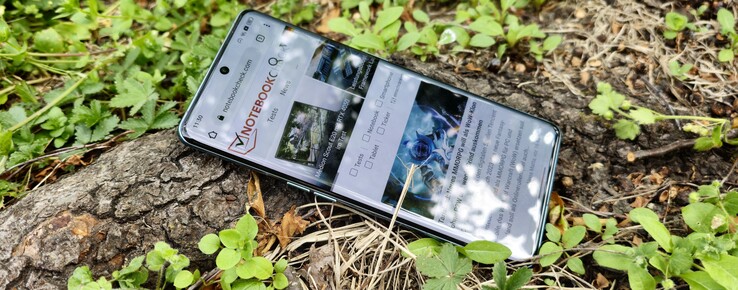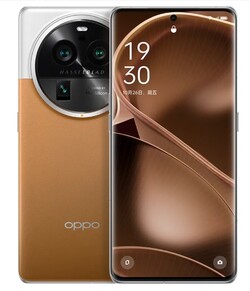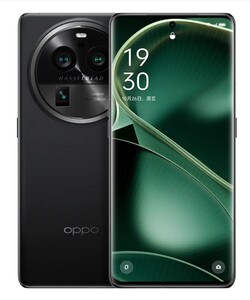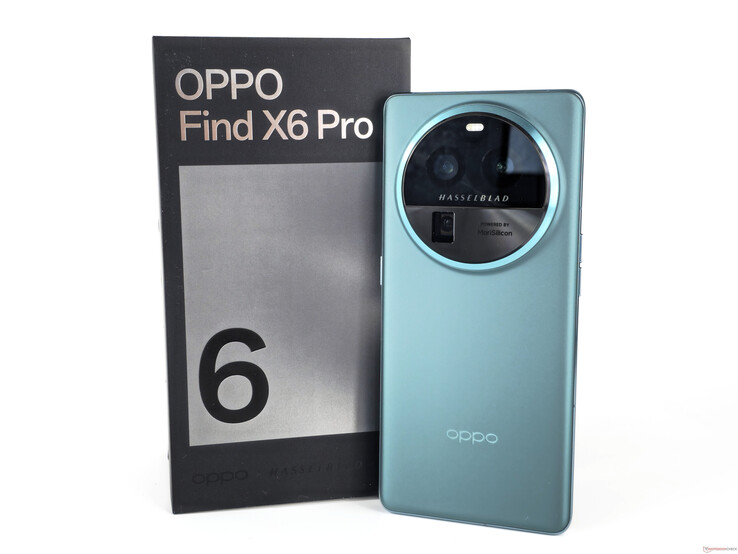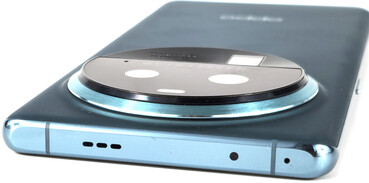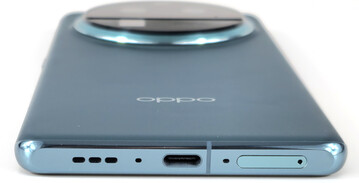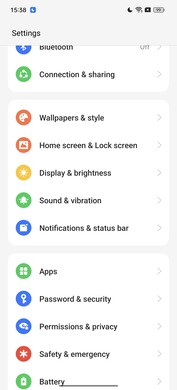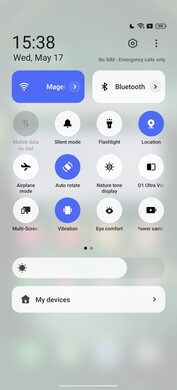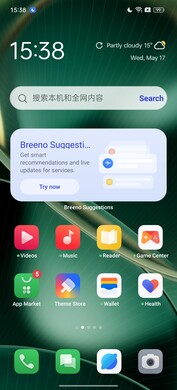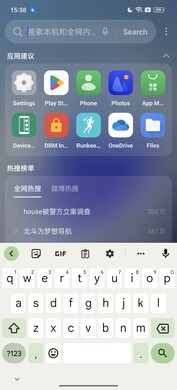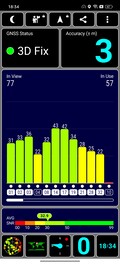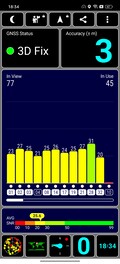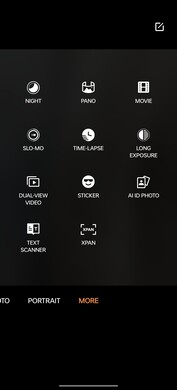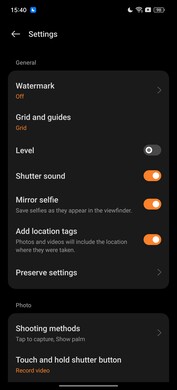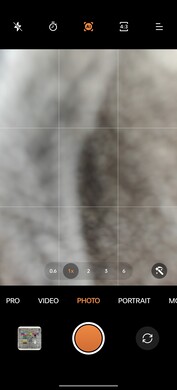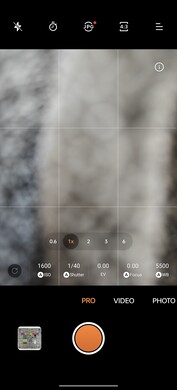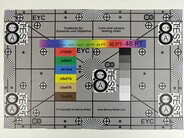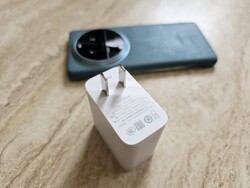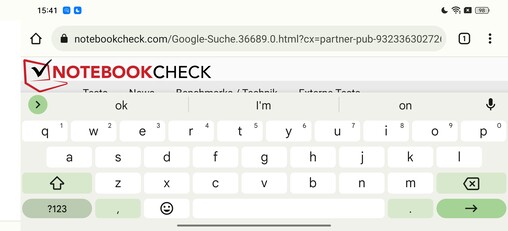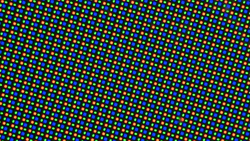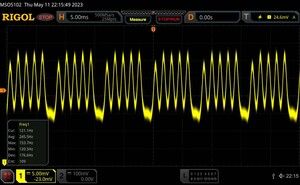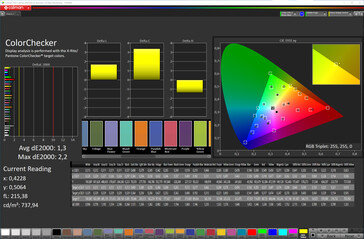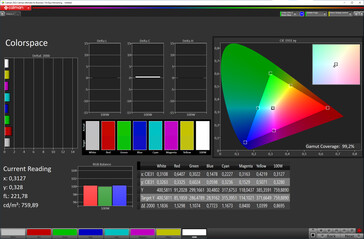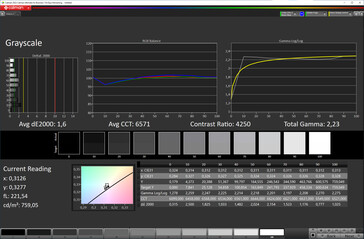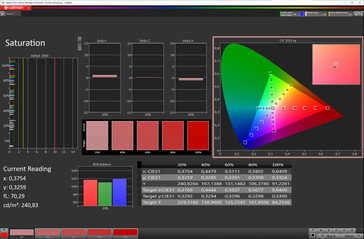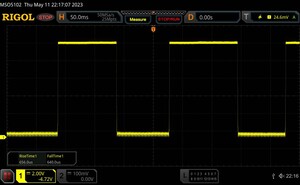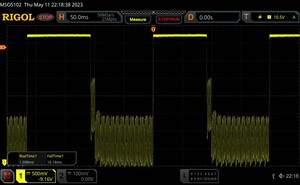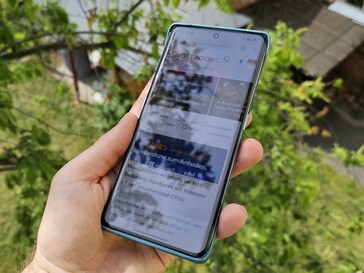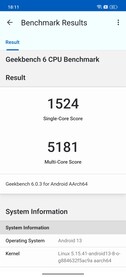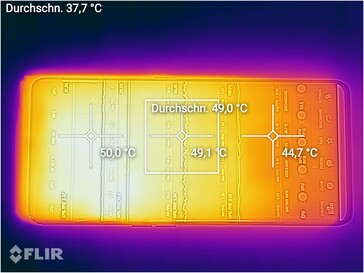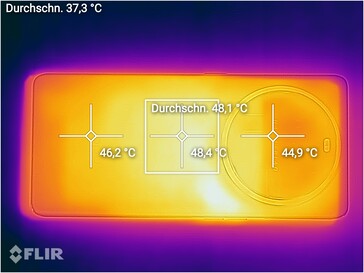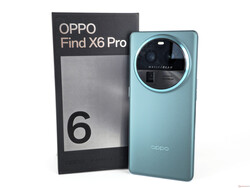Oppo Find X6 Pro review: Imposing flagship smartphone with improved Hasselblad cameras
The Find X6 Pro is Oppo's answer to the Galaxy S23 Ultra and Xiaomi 13 Ultra. While the Xiaomi 13 Ultra is also planned for the European market, the Oppo flagship is unfortunately only available in China. A global launch is uncertain, especially since BBK Electronics still has to deal with a sales ban in Germany.
The successor to the X5 Pro, which is (still) available in Germany, again focuses on the camera system, which, like in the past, was developed together with Hasselblad. With Sony's IMX989 in 1-inch format as the basis for the main camera and its own MariSilicon X NPU for image optimization, the Chinese manufacturer hopes to give its strong competitors in the premium smartphone segment a run for their money.
Otherwise, the X6 Pro offers high-end hardware that is to be expected for the price range, which includes a 6.82-inch, high-resolution 1,440p AMOLED display with a dynamic refresh rate of up to 120 Hz, a Snapdragon 8 Gen 2 from Qualcomm and up to 16 GB of LPDDR5X RAM and 512 GB UFS 4.0 flash storage. As an import, prices for the flagship from Oppo start at around US$1,029.31.
Possible competitors in comparison
Rating | Date | Model | Weight | Drive | Size | Resolution | Price |
|---|---|---|---|---|---|---|---|
| 88.9 % v7 (old) | 05 / 2023 | Oppo Find X6 Pro SD 8 Gen 2, Adreno 740 | 218 g | 256 GB UFS 4.0 Flash | 6.82" | 3168x1440 | |
| 89.2 % v7 (old) | 04 / 2022 | Oppo Find X5 Pro SD 8 Gen 1, Adreno 730 | 221 g | 256 GB UFS 3.1 Flash | 6.70" | 3216x1440 | |
| 89.7 % v7 (old) | 06 / 2023 | Xiaomi 13 Ultra SD 8 Gen 2, Adreno 740 | 227 g | 512 GB UFS 4.0 Flash | 6.73" | 3200x1440 | |
| 91.1 % v7 (old) | 03 / 2023 | Samsung Galaxy S23 Ultra SD 8 Gen 2 for Galaxy, Adreno 740 | 233 g | 256 GB UFS 4.0 Flash | 6.80" | 3080x1440 | |
| 89.1 % v7 (old) | 11 / 2022 | Google Pixel 7 Pro Tensor G2, Mali-G710 MP7 | 212 g | 128 GB UFS 3.1 Flash | 6.70" | 3120x1440 |
Case - Oppo cell phone with IP rating
The Find X6 Pro's IP68-rated case is available with a tempered glass back in black and green as well as a brown-silver faux leather/glass hybrid variant. Thanks to its matte surface, fingerprints are not an issue, but this also makes the Oppo smartphone somewhat slippery in the hands, so a secure grip is not always a given. The Find X6 Pro is quite heavy at 218 grams, but doesn't feel too bulky thanks to its rounded edges and even weight distribution.
From the front, the Oppo flagship is hardly distinguishable from its predecessor. The form factor is almost identical. Only the placement of the punch hole makes it obvious that this is the successor to the Find X5 Pro. In contrast to the back, the Chinese manufacturer specifies the material used on the front - Corning Gorilla Glass Victus 2.
The workmanship of the Find X6 Pro is top notch. Gaps are very tight and mostly flush. The size ratio between the display and its edges is very good at 90 percent.
Equipment - Oppo smartphone with UFS 4.0
The Find X6 Pro makes use of a fast USB port, which works according to the USB 3.2 (Gen. 1) standard, supports USB OTG and wired image output. During our copy test with a connected M2.SSD hard drive (Samsung 980 Pro), the transfer speed of the USB port was a strong 544 MB/s. The option of memory expansion as well as an audio jack have been omitted in the Find X6 Pro. Only two UFS storage variants are available:
- Oppo Find X6 Pro | 12GB LPDDR5X RAM | 256GB UFS 4.0 storage
- Oppo Find X6 Pro | 16GB LPDDR5X RAM | 256GB UFS 4.0 storage
- Oppo Find X6 Pro | 16GB LPDDR5X RAM | 512GB UFS 4.0 storage
In addition to fast storage, the smartphone comes with Bluetooth 5.3, an IR blaster and NFC, making it very well equipped. Only an ultra-wideband chip is not available in the Find X6 Pro.
Software - Oppo cell phone with Android 13
The Find X6 Pro comes with Android 13 and the in-house ColorOS 13.1 user interface. The manufacturer recently announced that the model will be provided with four major Android updates. Oppo also guarantees five years of security patches. This not only significantly improves Opp's 2023 premium smartphone, but also draws level with the Samsung Galaxy series.
The security patches on our test device were from April 2023. Since no global version of the Find X6 Pro is expected this year, we simply have to make do with the Chinese Color OS variant. This includes only three languages (English, Chinese, French) and no Google apps ex works, such as Gmail or the PlayStore. However, the Google Servies Framework is already preinstalled in the state of delivery.
Communication and GNSS - Oppo Find X6 Pro with 5G
In the WLAN network, the Find X6 Pro scores with largely constant transfer rates, but establishing a connection proved to be sluggish in our tests. As expected for a smartphone in this price range, the premium Oppo smartphone utilizes the modern Wi-Fi 7 standard. However, our test device is unable to utilize the 6 gigahertz frequency band for Wi-Fi transmissions. We were also unable to conclusively clarify whether the Find X6 Pro supports the IEEE 802.11-be standard for WLAN, whether it indeed does not support the 6 GHz standard (like the Honor Magic5 Pro) or if there are other reasons. In conjunction with our Asus ROG Rapture GT-AXE11000 reference router, the transfer rates of the Oppo flagship are thus quite low.
For mobile internet access, the Oppo smartphone supports all current mobile communications standards, including 5G-Sub6, with a broad frequency range. At a total of 20 supported LTE bands, including band 20 and 28, nothing stands in the way of use in most places around the globe.
For localization, the Oppo smartphone employs the main satellite systems GPS (L1+L5), GLONASS (G1), BeiDou (B1+B2) and Galileo (E1+E5) as well as SBAS. In order to assess the smartphone's real-world tracking capabilities, we took it on a short bike trip and recorded the route in tandem with a Garmin Venu 2 for comparison purposes.
We really like the tracking capabilities of the Find X6 Pro. Deviations from the actual route taken are hardly noticeable in the detailed history of the GPS recording. Only in a few places does the smartphone display minimal deviations.
Route recording: Oppo Find X6 Pro vs. Garmin Venu 2
Telephony and Voice Quality - Oppo smartphone with dual SIM
Cameras - Oppo phone with 1 inch sensor
Technically, the front camera of the Oppo Find X6 Pro has hardly evolved compared to its predecessor. The optics operate at 32 MP without pixel binning and deliver good image quality in daylight with minimal weaknesses in exposure. Unfortunately, video recordings are still limited to 1080p with a sensor resolution of 6560x4928.
A wide-angle lens with Sony's IMX989 in 1-inch format is used on the back, just like in Chinese rivals Xiaomi 13 Ultra and Vivo X90 Pro+. Photos taken with the main camera and at a standard resolution of 12.5 MP look less digitally sharpened than those of the Honor Magic5 Pro – which is not bad in principle - but the level of sharpness could be higher. Blurring is clearly visible, especially in the peripheral areas.
The camera trio is rounded off by an ultra wide-angle lens and a periscope telephoto lens, both of which utilize OIS and a resolution of 50 MP, including pixel binning. The ultra-wide-angle optics with its equivalent focal length of 15 millimeters and 110-degree viewing angle impress with a detailed depth of field and the image sharpness is very good, even in the peripheral areas. Furthermore, the Find X6 Pro hardly reveals any artifacts in recordings. The lens also serves as a macro lens.
The telephoto optic also uses the Sony IMX 890, but offers triple optical zoom with an equivalent focal length of 65 millimeters and a digital magnification of 100x. Photos taken via the 1/1.56 format image sensor are rich in detail, but could be a bit better color-tuned to the other two cameras. Moreover, at 6x hybrid zoom, the photos could also do with a little more sharpness. In this discipline, a Xiaomi 13 Ultra or Galaxy S23 Ultra offer better photo quality.
Videos can be recorded in UHD and at a maximum of 60 frames per second with all cameras in the Find X6 Pro. An 8K option isn't available on the Sony IMX989 main camera, which is unexpected. Switching between the different lenses is possible without major stutters, but only at 30 fps. Video stabilization is very impressive and thanks to OIS, good results can be achieved from the ultra wide-angle to the telephoto range (3x zoom).
Image comparison
Choose a scene and navigate within the first image. One click changes the position on touchscreens. One click on the zoomed-in image opens the original in a new window. The first image shows the scaled photograph of the test device.
Wide angleWide angleLow lightUltra wide angleZoom 5xUnder controlled light conditions, we analyzed the color reproduction of the Find X6 Pro in comparison to the actual reference colors. In addition to slight brightening, the 50 MP optics of the main sensor reveals minor deviations in the ColorChecker passport. There were no outliers in color fidelity (>10) at all. However, the white balance is clearly too warm.
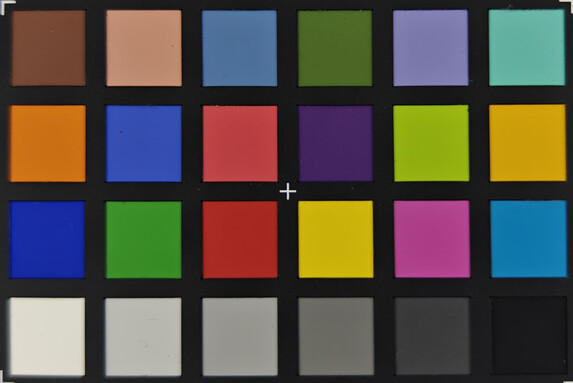
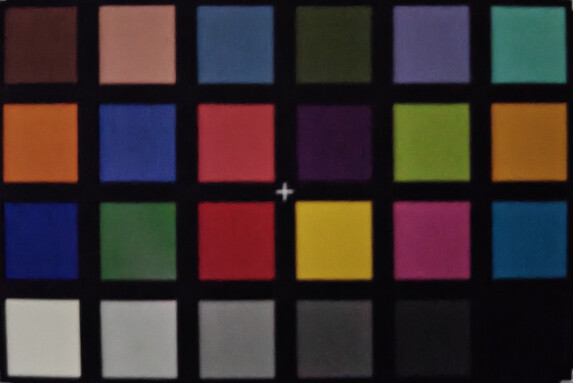
Accessories and Warranty - Oppo Find X6 Pro with AC adapter
The Find X6 Pro comes with a modular 100-watt power supply, a data and charging cable, a protective case, a SIM pin and a quick start guide. In addition, our lender TradingShenzhen included an EU adapter for the charger and a USB-OTG adapter in the scope of delivery of our Chinese test model.
The warranty on the Oppo smartphone is 12 months.
Input Devices & Operation - Oppo smartphone with FaceUnlock
Inputs are accurately implemented on the large 6.82-inch OLED touchscreen display right up to the corners. A protective film is installed ex-works. At a sampling rate of 240Hz, the LTPO panel responds to touches with high sensitivity and refreshes up to 240 times per second, such as in gaming, which ensures low input latency.
The optical fingerprint sensor is integrated in the display and unlocks the smartphone very reliably and quickly. A rather unsecure 2D facial recognition method, which is based on the FaceUnlock function via the front camera, is also available.
As in the predecessor, the Chinese manufacturer has installed a high-quality vibration motor that provides nice haptics and precise feedback in everyday use.
Display - Oppo Phone with AMOLED
The Find X6 Pro has a 6.82-inch OLED display with a resolution of 3,168 x 1,440 and uses adaptive refresh rate control. The Chinese manufacturer's flagship smartphone can automatically adapt this to the displayed content and should regulate between 1 and 120 Hz. However, according to the system data readout, the Oppo flagship currently only uses a minimum of 5 Hz.
The maximum brightness of the Find X6 Pro is specified as 2,500 nits, although we were unable to prove this in our measurements. On a pure white surface, the AMOLED panel achieves a good 1225 cd/m² at its peak. If we throw in some dark areas on the display, the brightness increases to 1,339 cd/m² in the APL18 test. So the Oppo smartphone not only falls well short of the advertised maximum brightness, but also does not even reach the manufacturer's specification of 1,500 nits for the HBM mode in the APL test.
| |||||||||||||||||||||||||
Brightness Distribution: 91 %
Center on Battery: 1109 cd/m²
Contrast: ∞:1 (Black: 0 cd/m²)
ΔE ColorChecker Calman: 1.3 | ∀{0.5-29.43 Ø4.77}
ΔE Greyscale Calman: 1.6 | ∀{0.09-98 Ø5}
99.2% sRGB (Calman 2D)
Gamma: 2.23
CCT: 6571 K
| Oppo Find X6 Pro AMOLED, 3168x1440, 6.8" | Oppo Find X5 Pro AMOLED, 3216x1440, 6.7" | Xiaomi 13 Ultra AMOLED, 3200x1440, 6.7" | Samsung Galaxy S23 Ultra Dynamic AMOLED 2x, 3080x1440, 6.8" | Google Pixel 7 Pro OLED, 3120x1440, 6.7" | |
|---|---|---|---|---|---|
| Screen | -1% | 0% | -31% | 9% | |
| Brightness middle (cd/m²) | 1109 | 746 -33% | 1357 22% | 1117 1% | 1022 -8% |
| Brightness (cd/m²) | 1190 | 744 -37% | 1340 13% | 1133 -5% | 1025 -14% |
| Brightness Distribution (%) | 91 | 97 7% | 89 -2% | 97 7% | 99 9% |
| Black Level * (cd/m²) | |||||
| Colorchecker dE 2000 * | 1.3 | 0.9 31% | 1.1 15% | 2.2 -69% | 0.9 31% |
| Colorchecker dE 2000 max. * | 2.2 | 1.6 27% | 2.7 -23% | 3.9 -77% | 2.1 5% |
| Greyscale dE 2000 * | 1.6 | 1.6 -0% | 2 -25% | 2.3 -44% | 1.1 31% |
| Gamma | 2.23 99% | 2.23 99% | 2.2 100% | 2.37 93% | 2.22 99% |
| CCT | 6571 99% | 6499 100% | 6366 102% | 6572 99% | 6650 98% |
* ... smaller is better
Like all OLED displays, the Oppo Find X6 Pro's screen flickers across the entire brightness spectrum. We measured a frequency of 120 Hz with a few outliers and a flat amplitude curve. As a result, the low frequency can still be classified as easy on the eyes.
Screen Flickering / PWM (Pulse-Width Modulation)
| Screen flickering / PWM detected | 120 Hz | ||
The display backlight flickers at 120 Hz (worst case, e.g., utilizing PWM) . The frequency of 120 Hz is very low, so the flickering may cause eyestrain and headaches after extended use. In comparison: 53 % of all tested devices do not use PWM to dim the display. If PWM was detected, an average of 8084 (minimum: 5 - maximum: 343500) Hz was measured. | |||
Series of measurements at a fixed zoom level and different brightness settings
Our photospectrometer analysis and the Calman software reveal very low average DeltaE deviations from the sRGB color space for the Oppo smartphone. However, the color representation of the display has to be adjusted with the right settings. For this, the color mode "Natural" and the color temperature should be set to the maximum "Warm" level in the display options. Color deviations are hardly visible to the naked eye.
In addition to "Natural", there are two other color profiles, settings for color filters and white balance. Furthermore, the light sensor can be used to automatically adjust color reproduction.
Display Response Times
| ↔ Response Time Black to White | ||
|---|---|---|
| 1.3 ms ... rise ↗ and fall ↘ combined | ↗ 0.656 ms rise | |
| ↘ 0.64 ms fall | ||
| The screen shows very fast response rates in our tests and should be very well suited for fast-paced gaming. In comparison, all tested devices range from 0.1 (minimum) to 240 (maximum) ms. » 6 % of all devices are better. This means that the measured response time is better than the average of all tested devices (20.2 ms). | ||
| ↔ Response Time 50% Grey to 80% Grey | ||
| 2.18 ms ... rise ↗ and fall ↘ combined | ↗ 1.098 ms rise | |
| ↘ 1.082 ms fall | ||
| The screen shows very fast response rates in our tests and should be very well suited for fast-paced gaming. In comparison, all tested devices range from 0.165 (minimum) to 636 (maximum) ms. » 10 % of all devices are better. This means that the measured response time is better than the average of all tested devices (31.6 ms). | ||
Although the Oppo smartphone cannot reach a peak brightness of over 2,000 nits, it still impresses outdoors all across the board. Thanks to the high luminosity of the panel and the OLED screen's strong contrasts, reflections on the screen are not a problem. Even those who control the brightness manually (without a sensor) have a comparatively high luminance of 788 cd/m² at their disposal.
The Find X6 Pro's viewing angle stability is very good. Only a slight loss of brightness can be seen at flat viewing angles.
Performance - Oppo Find X6 Pro with Qualcomm SoC
The Find X6 Pro deploys the Snapdragon 8 Gen 2 with 16 GB of LPDDR5x RAM. However, the smartphone's high performance capabilities are not immediately available ex-factory. The High Performance mode has to be enabled in the battery settings first, otherwise the Qualcomm chipset does not tap its full potential. The single-core of Geekbench 6 shows that the prime core (Cortex-X3) in particular is affected by the standard performance reduction.
We used High Performance mode for our benchmarks. The Find X6 Pro performs very well here, roughly at the level of a Xiaomi 13 Ultra and Galaxy S23 Ultra. In the PCMark system benchmark, however, the Oppo smartphone falls short of expectations. In addition, the Antutu test reports that an abnormally high value was reached, which could be related to "cheating".
| UL Procyon AI Inference for Android - Overall Score NNAPI | |
| Oppo Find X5 Pro | |
| Google Pixel 7 Pro | |
| Average of class Smartphone (3769 - 81594, n=132, last 2 years) | |
| Samsung Galaxy S23 Ultra | |
| Oppo Find X6 Pro | |
| Xiaomi 13 Ultra | |
| Average Qualcomm Snapdragon 8 Gen 2 (11338 - 16880, n=21) | |
The performance of the Adreno 740 is also high in the graphics benchmarks, but the Find X6 Pro remains below what the graphics unit can theoretically achieve in the on-screen values of GFXBench. Although the panel's full 120 Hz is available, the results remain at just 60 fps. The reason for this is revealed in the 3DMark stress tests and leaves little hope for HFR gaming.
GFXBench (DX / GLBenchmark) 2.7: T-Rex Onscreen | 1920x1080 T-Rex Offscreen
GFXBench 3.0: on screen Manhattan Onscreen OGL | 1920x1080 1080p Manhattan Offscreen
GFXBench 3.1: on screen Manhattan ES 3.1 Onscreen | 1920x1080 Manhattan ES 3.1 Offscreen
GFXBench: on screen Car Chase Onscreen | 1920x1080 Car Chase Offscreen | on screen Aztec Ruins High Tier Onscreen | 2560x1440 Aztec Ruins High Tier Offscreen | on screen Aztec Ruins Normal Tier Onscreen | 1920x1080 Aztec Ruins Normal Tier Offscreen | 3840x2160 4K Aztec Ruins High Tier Offscreen
| 3DMark / Wild Life Extreme Unlimited | |
| Samsung Galaxy S23 Ultra | |
| Oppo Find X6 Pro | |
| Xiaomi 13 Ultra | |
| Oppo Find X5 Pro | |
| Google Pixel 7 Pro | |
| 3DMark / Wild Life Extreme | |
| Samsung Galaxy S23 Ultra | |
| Xiaomi 13 Ultra | |
| Oppo Find X6 Pro | |
| Oppo Find X5 Pro | |
| Google Pixel 7 Pro | |
| 3DMark / Wild Life Unlimited Score | |
| Samsung Galaxy S23 Ultra | |
| Oppo Find X6 Pro | |
| Xiaomi 13 Ultra | |
| Oppo Find X5 Pro | |
| Google Pixel 7 Pro | |
| 3DMark / Wild Life Score | |
| Oppo Find X5 Pro | |
| Google Pixel 7 Pro | |
| Oppo Find X6 Pro | |
| 3DMark / Sling Shot Extreme (ES 3.1) Unlimited Physics | |
| Oppo Find X6 Pro | |
| Xiaomi 13 Ultra | |
| Samsung Galaxy S23 Ultra | |
| Google Pixel 7 Pro | |
| Oppo Find X5 Pro | |
| 3DMark / Sling Shot Extreme (ES 3.1) Unlimited Graphics | |
| Oppo Find X6 Pro | |
| Xiaomi 13 Ultra | |
| Samsung Galaxy S23 Ultra | |
| Oppo Find X5 Pro | |
| Google Pixel 7 Pro | |
| 3DMark / Sling Shot Extreme (ES 3.1) Unlimited | |
| Oppo Find X6 Pro | |
| Xiaomi 13 Ultra | |
| Samsung Galaxy S23 Ultra | |
| Oppo Find X5 Pro | |
| Google Pixel 7 Pro | |
| GFXBench (DX / GLBenchmark) 2.7 / T-Rex Onscreen | |
| Google Pixel 7 Pro | |
| Samsung Galaxy S23 Ultra | |
| Xiaomi 13 Ultra | |
| Oppo Find X5 Pro | |
| Oppo Find X6 Pro | |
| GFXBench (DX / GLBenchmark) 2.7 / T-Rex Offscreen | |
| Samsung Galaxy S23 Ultra | |
| Xiaomi 13 Ultra | |
| Oppo Find X6 Pro | |
| Oppo Find X5 Pro | |
| Google Pixel 7 Pro | |
| GFXBench 3.0 / Manhattan Onscreen OGL | |
| Xiaomi 13 Ultra | |
| Samsung Galaxy S23 Ultra | |
| Google Pixel 7 Pro | |
| Oppo Find X5 Pro | |
| Oppo Find X6 Pro | |
| GFXBench 3.0 / 1080p Manhattan Offscreen | |
| Xiaomi 13 Ultra | |
| Samsung Galaxy S23 Ultra | |
| Oppo Find X6 Pro | |
| Oppo Find X5 Pro | |
| Google Pixel 7 Pro | |
| GFXBench 3.1 / Manhattan ES 3.1 Onscreen | |
| Xiaomi 13 Ultra | |
| Samsung Galaxy S23 Ultra | |
| Oppo Find X6 Pro | |
| Oppo Find X5 Pro | |
| Google Pixel 7 Pro | |
| GFXBench 3.1 / Manhattan ES 3.1 Offscreen | |
| Xiaomi 13 Ultra | |
| Samsung Galaxy S23 Ultra | |
| Oppo Find X6 Pro | |
| Oppo Find X5 Pro | |
| Google Pixel 7 Pro | |
| GFXBench / Car Chase Onscreen | |
| Samsung Galaxy S23 Ultra | |
| Xiaomi 13 Ultra | |
| Oppo Find X6 Pro | |
| Oppo Find X5 Pro | |
| Google Pixel 7 Pro | |
| GFXBench / Car Chase Offscreen | |
| Oppo Find X6 Pro | |
| Xiaomi 13 Ultra | |
| Samsung Galaxy S23 Ultra | |
| Google Pixel 7 Pro | |
| Oppo Find X5 Pro | |
| GFXBench / Aztec Ruins High Tier Onscreen | |
| Samsung Galaxy S23 Ultra | |
| Oppo Find X6 Pro | |
| Xiaomi 13 Ultra | |
| Oppo Find X5 Pro | |
| Google Pixel 7 Pro | |
| GFXBench / Aztec Ruins High Tier Offscreen | |
| Samsung Galaxy S23 Ultra | |
| Xiaomi 13 Ultra | |
| Oppo Find X6 Pro | |
| Oppo Find X5 Pro | |
| Google Pixel 7 Pro | |
| GFXBench / Aztec Ruins Normal Tier Onscreen | |
| Samsung Galaxy S23 Ultra | |
| Xiaomi 13 Ultra | |
| Oppo Find X6 Pro | |
| Oppo Find X5 Pro | |
| Google Pixel 7 Pro | |
| GFXBench / Aztec Ruins Normal Tier Offscreen | |
| Samsung Galaxy S23 Ultra | |
| Xiaomi 13 Ultra | |
| Oppo Find X6 Pro | |
| Oppo Find X5 Pro | |
| Google Pixel 7 Pro | |
| GFXBench / 4K Aztec Ruins High Tier Offscreen | |
| Samsung Galaxy S23 Ultra | |
| Xiaomi 13 Ultra | |
| Oppo Find X6 Pro | |
| Google Pixel 7 Pro | |
In the browser benchmarks, which we tested with Chrome, the Find X6 Pro delivers very good results and strong performance in everyday use without significant delays when scrolling or opening complex websites.
| Jetstream 2 - 2.0 Total Score | |
| Xiaomi 13 Ultra (Chrome 113) | |
| Samsung Galaxy S23 Ultra (Chrome 109) | |
| Oppo Find X6 Pro (Chrome 113) | |
| Average of class Smartphone (23.8 - 387, n=147, last 2 years) | |
| Average Qualcomm Snapdragon 8 Gen 2 (62.7 - 179.2, n=23) | |
| Oppo Find X5 Pro (Chrome 99) | |
| Google Pixel 7 Pro (Chrome 106) | |
| Speedometer 2.0 - Result 2.0 | |
| Average of class Smartphone (15.2 - 643, n=119, last 2 years) | |
| Xiaomi 13 Ultra (Chrome 113) | |
| Oppo Find X6 Pro (Chrome 113) | |
| Samsung Galaxy S23 Ultra (Chrome 109) | |
| Average Qualcomm Snapdragon 8 Gen 2 (62.9 - 225, n=18) | |
| Oppo Find X5 Pro (Chrome 99) | |
| Google Pixel 7 Pro (Chrome 106) | |
| WebXPRT 4 - Overall | |
| Average of class Smartphone (27 - 306, n=143, last 2 years) | |
| Oppo Find X6 Pro (Chrome 113) | |
| Samsung Galaxy S23 Ultra (Chrome 110) | |
| Xiaomi 13 Ultra (Chrome 113) | |
| Average Qualcomm Snapdragon 8 Gen 2 (28 - 183, n=22) | |
| Google Pixel 7 Pro (Chrome 106) | |
| WebXPRT 3 - Overall | |
| Oppo Find X6 Pro (Chrome 113) | |
| Xiaomi 13 Ultra (Chrome 113) | |
| Average Qualcomm Snapdragon 8 Gen 2 (115 - 238, n=11) | |
| Average of class Smartphone (38 - 380, n=30, last 2 years) | |
| Oppo Find X5 Pro (Chrome 99) | |
| Google Pixel 7 Pro (Chrome 106) | |
| Octane V2 - Total Score | |
| Xiaomi 13 Ultra (Chrome 113) | |
| Samsung Galaxy S23 Ultra (Chrome 109) | |
| Oppo Find X6 Pro (Chrome 113) | |
| Average of class Smartphone (2228 - 126661, n=194, last 2 years) | |
| Average Qualcomm Snapdragon 8 Gen 2 (19870 - 65418, n=25) | |
| Google Pixel 7 Pro (Chrome 106) | |
| Oppo Find X5 Pro (Chrome 99) | |
| Mozilla Kraken 1.1 - Total | |
| Average of class Smartphone (257 - 28190, n=154, last 2 years) | |
| Oppo Find X5 Pro (Chrome 99) | |
| Average Qualcomm Snapdragon 8 Gen 2 (602 - 1837, n=22) | |
| Google Pixel 7 Pro (Chrome 106) | |
| Oppo Find X6 Pro (Chrome 113) | |
| Samsung Galaxy S23 Ultra (Chrome 109) | |
| Xiaomi 13 Ultra (Chrome 113) | |
* ... smaller is better
In terms of storage speed, the fourth-generation UFS storage of Oppo's smartphone delivers excellent performance. However, the AndroBench scores are a good deal lower than on a Xiaomi 13 Ultra.
| Oppo Find X6 Pro | Oppo Find X5 Pro | Xiaomi 13 Ultra | Samsung Galaxy S23 Ultra | Google Pixel 7 Pro | Average 256 GB UFS 4.0 Flash | Average of class Smartphone | |
|---|---|---|---|---|---|---|---|
| AndroBench 3-5 | -60% | 9% | -27% | -56% | -6% | -32% | |
| Sequential Read 256KB (MB/s) | 3307.82 | 1410 -57% | 4511.82 36% | 3426.56 4% | 1346.78 -59% | 3664 ? 11% | 2235 ? -32% |
| Sequential Write 256KB (MB/s) | 2842.59 | 894 -69% | 2878.39 1% | 1389.84 -51% | 874.73 -69% | 2701 ? -5% | 1871 ? -34% |
| Random Read 4KB (MB/s) | 413.21 | 183.7 -56% | 398.87 -3% | 449.77 9% | 219.01 -47% | 381 ? -8% | 297 ? -28% |
| Random Write 4KB (MB/s) | 505.72 | 210.4 -58% | 507.27 0% | 152.92 -70% | 253.18 -50% | 405 ? -20% | 343 ? -32% |
Gaming - Oppo smartphone only manages 60 fps
Those who want to play one or the other game from the Play Store can definitely reach for the Find X6 Pro, but gamers will not be happy with Oppo's smartphone. We used the GameBench app to take a look at how smoothly PUBG mobile and Armajet run, but the scores in GFXBench are already a bad omen.
Indeed, even in the two games, the premium smartphone from Oppo is unable to manage more than 60 fps. With PUBG mobile, the said 60 fps is constant in medium details (HD mode), but if we increase the graphics details (UHD), the graphics unit only manages a smooth 40 frames per second.
Emissions - The Oppo smartphone does not stay cool
Temperature
The glass case on the back heats up considerably under sustained load. Since our temperature measurement under load is now based on the Burnout benchmark instead of the stability test, a comparison with flagship smartphones with the Snapdragon 8 Gen 2 that have already been tested is only possible to a limited extent. The Find X6 Pro was unable to complete our measurement or the benchmark test due to strong waste heat.
We carried out stress testing with 3DMark in order to check internal heat development. Here, the Qualcomm SoC reveals high fluctuation under computationally intensive load. The Find X6 Pro throttles almost two-thirds of its performance, which is likely to be noticeable in everyday use during longer gaming sessions. In summer temperatures, performance losses under load on Oppo's smartphone cannot be ruled out.
(-) The maximum temperature on the upper side is 51.8 °C / 125 F, compared to the average of 35.2 °C / 95 F, ranging from 21.9 to 247 °C for the class Smartphone.
(-) The bottom heats up to a maximum of 48 °C / 118 F, compared to the average of 34 °C / 93 F
(+) In idle usage, the average temperature for the upper side is 31.5 °C / 89 F, compared to the device average of 32.9 °C / 91 F.
3DMark Wild Life Stress Test
| 3DMark | |
| Wild Life Stress Test Stability | |
| Xiaomi 13 Ultra | |
| Samsung Galaxy S23 Ultra | |
| Google Pixel 7 Pro | |
| Oppo Find X5 Pro | |
| Oppo Find X6 Pro | |
| Wild Life Extreme Stress Test | |
| Xiaomi 13 Ultra | |
| Google Pixel 7 Pro | |
| Oppo Find X5 Pro | |
| Samsung Galaxy S23 Ultra | |
| Oppo Find X6 Pro | |
Speakers
The stereo speakers offer very good audio quality for a smartphone. The speakers are very loud at almost 90 dA and the sound quality is characterized by linear mids with a touch of bass. The super tweeters drop a little in the pink noise diagram.
Headphones can be connected to the Find X6 Pro via the USB-C port. Alternatively, Bluetooth 5.3 is available for wireless transmission. A wide range of audio codecs is available: SBC, AAC, aptX, aptX HD, aptX Adaptive and aptX TWS+ as well as LDAC and LDHC.
Oppo Find X6 Pro audio analysis
(+) | speakers can play relatively loud (89.4 dB)
Bass 100 - 315 Hz
(-) | nearly no bass - on average 24.7% lower than median
(±) | linearity of bass is average (10.9% delta to prev. frequency)
Mids 400 - 2000 Hz
(+) | balanced mids - only 4% away from median
(+) | mids are linear (4% delta to prev. frequency)
Highs 2 - 16 kHz
(±) | higher highs - on average 5% higher than median
(+) | highs are linear (3.1% delta to prev. frequency)
Overall 100 - 16.000 Hz
(±) | linearity of overall sound is average (18.5% difference to median)
Compared to same class
» 20% of all tested devices in this class were better, 9% similar, 71% worse
» The best had a delta of 11%, average was 35%, worst was 134%
Compared to all devices tested
» 41% of all tested devices were better, 8% similar, 52% worse
» The best had a delta of 4%, average was 24%, worst was 134%
Samsung Galaxy S23 Ultra audio analysis
(+) | speakers can play relatively loud (91.8 dB)
Bass 100 - 315 Hz
(-) | nearly no bass - on average 19.4% lower than median
(+) | bass is linear (5.1% delta to prev. frequency)
Mids 400 - 2000 Hz
(±) | reduced mids - on average 5.1% lower than median
(+) | mids are linear (4.2% delta to prev. frequency)
Highs 2 - 16 kHz
(±) | higher highs - on average 6.2% higher than median
(+) | highs are linear (2.5% delta to prev. frequency)
Overall 100 - 16.000 Hz
(±) | linearity of overall sound is average (15.6% difference to median)
Compared to same class
» 4% of all tested devices in this class were better, 3% similar, 93% worse
» The best had a delta of 11%, average was 35%, worst was 134%
Compared to all devices tested
» 23% of all tested devices were better, 4% similar, 73% worse
» The best had a delta of 4%, average was 24%, worst was 134%
Battery Life - Oppo Find X6 Pro with fast charging
Power Consumption
The Oppo Find X6 Pro has a 5,000 mAh battery that can be charged with a maximum of 100 watts via cable. When completely empty, the Oppo smartphone has to remain connected to the power cable for a little more than 30 minutes for a full charge. A sufficiently fast charger is fortunately included in the scope of delivery. Wireless charging via the Qi fast charging protocol is also supported with a maximum of 50 watts. This is further supplemented by 10-watt reverse wireless charging.
The power consumption is unremarkable overall, but the Oppo smartphone could use a little less power when idling. A Galaxy S23 Ultra shows that a flagship with similar hardware can get by with less than 1 watt in idle mode.
| Off / Standby | |
| Idle | |
| Load |
|
Key:
min: | |
| Oppo Find X6 Pro 5000 mAh | Oppo Find X5 Pro 5000 mAh | Xiaomi 13 Ultra 5000 mAh | Samsung Galaxy S23 Ultra 5000 mAh | Google Pixel 7 Pro 5000 mAh | Average Qualcomm Snapdragon 8 Gen 2 | Average of class Smartphone | |
|---|---|---|---|---|---|---|---|
| Power Consumption | -5% | 3% | 6% | 5% | -42% | -32% | |
| Idle Minimum * (Watt) | 0.87 | 1.24 -43% | 0.86 1% | 0.9 -3% | 0.78 10% | 1.036 ? -19% | 0.847 ? 3% |
| Idle Average * (Watt) | 1.6 | 1.39 13% | 1.53 4% | 1.05 34% | 1.61 -1% | 1.766 ? -10% | 1.448 ? 9% |
| Idle Maximum * (Watt) | 1.68 | 1.42 15% | 1.64 2% | 1.1 35% | 1.63 3% | 1.94 ? -15% | 1.633 ? 3% |
| Load Average * (Watt) | 3.65 | 3.58 2% | 3.12 15% | 3.99 -9% | 3.29 10% | 7.22 ? -98% | 6.96 ? -91% |
| Load Maximum * (Watt) | 6.14 | 6.99 -14% | 6.5 -6% | 7.82 -27% | 6.01 2% | 10.4 ? -69% | 11.3 ? -84% |
* ... smaller is better
Power consumption: Geekbench (150 cd/m²)
Power consumption: GFXBench (150 cd/m²)
Battery Life
In our real-world battery tests, the Find X6 Pro delivers a good runtime of 15.5 hours in the Wi-Fi test at a refresh rate of 120 Hz, which is performed with an adjusted display brightness of 150 cd/m². The Oppo smartphone lasts over 10 hours longer in video playback with the WLAN module disabled, which speaks for a very energy-hungry communication module. On the other hand, 27.5 hours in the video test is a fantastic rate and also speaks for rather efficient energy management.
| Oppo Find X6 Pro 5000 mAh | Oppo Find X5 Pro 5000 mAh | Xiaomi 13 Ultra 5000 mAh | Samsung Galaxy S23 Ultra 5000 mAh | Google Pixel 7 Pro 5000 mAh | |
|---|---|---|---|---|---|
| Battery runtime | -7% | -2% | 24% | -24% | |
| Reader / Idle (h) | 28.8 | 21.2 -26% | 28.8 0% | 35.7 24% | 20.2 -30% |
| H.264 (h) | 27.5 | 19 -31% | 16.8 -39% | 25.7 -7% | 20.2 -27% |
| WiFi v1.3 (h) | 15.6 | 13.1 -16% | 17.8 14% | 18.3 17% | 11.3 -28% |
| Load (h) | 4.2 | 6.1 45% | 5 19% | 6.7 60% | 3.8 -10% |
Pros
Cons
Verdict on the Oppo Find X6 Pro
The Find X6 Pro is likely to remain a rarity in Germany due to the lack of availability, which is a pity, because the Oppo flagship is an interesting alternative to the Honor Magic5 Pro or Galaxy S23 Ultra. At least fans of the flagship smartphone from Oppo can look forward to broad LTE coverage, including bands 20 and 28, which Xiaomi does not provide with its Chinese version of the 13 Ultra, for example.
The large discrepancy between the manufacturer's specifications and our measurements in the area of display brightness is annoying. At around 1,300 cd/m², the otherwise very nice LTPO panel does not come close to the advertised peak brightness of 2,500 nits. In its core area, the cameras, the Find X6 Pro is not on the overall level of a Galaxy S23 Ultra or Xiaomi 13 Ultra. Nevertheless, the strong ultra-wide-angle camera might make it the better camera package for some users.
Hopefully, the European abstinence of Oppo's flagship will not be an issue in the coming year
Technically, Oppo does a lot right with its Find X6 Pro. The only complaints are the somewhat too slow Wi-Fi transfer rates and the high waste heat in connection with the pronounced throttling. Why the Snapdragon 8 Gen 2 is only allowed to tap its full potential under the very hidden High Performance mode remains a secret of the Chinese manufacturer - this is certainly not because of the battery runtimes, which are very impressive in the Find X6 Pro.
Price and Availability
All three color variants can be purchased as imports at TradingSchenzen in a wide range of currencies. In US dollar, for example, the 12GB/256GB configuration is priced at $1,029.31, the 16GB/256GB for $1,126.11 and the 16GB/512GB for $1,201.40.
Oppo Find X6 Pro
- 05/26/2023 v7 (old)
Marcus Herbrich
Transparency
The selection of devices to be reviewed is made by our editorial team. The test sample was provided to the author as a loan by the manufacturer or retailer for the purpose of this review. The lender had no influence on this review, nor did the manufacturer receive a copy of this review before publication. There was no obligation to publish this review. As an independent media company, Notebookcheck is not subjected to the authority of manufacturers, retailers or publishers.
This is how Notebookcheck is testing
Every year, Notebookcheck independently reviews hundreds of laptops and smartphones using standardized procedures to ensure that all results are comparable. We have continuously developed our test methods for around 20 years and set industry standards in the process. In our test labs, high-quality measuring equipment is utilized by experienced technicians and editors. These tests involve a multi-stage validation process. Our complex rating system is based on hundreds of well-founded measurements and benchmarks, which maintains objectivity. Further information on our test methods can be found here.




